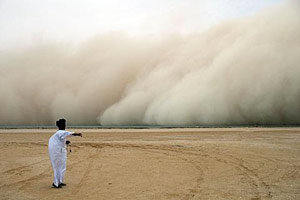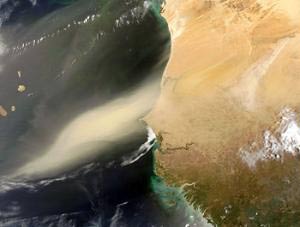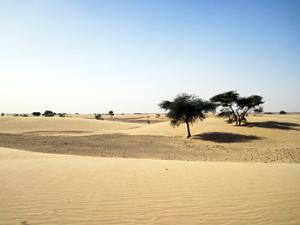|
 Dust storm in the Sahara |
Dust is more than a housekeeping nuisance. To climate scientists, dust is a force of nature. It's the most abundant particle in the atmosphere, and it reflects sunlight and heat.
The world's biggest source of dust is the Sahara desert and Sahel region of West Africa. The influence West African dust has on the environment is surprisingly wide-ranging, according to Stefan Mulitza, a marine geologist at the University of Bremen in Germany.
"It probably interacts with cloud formation; people think that it has an influence on the quantity of precipitation; hurricane activity through the cooling of the sea surface is probably affected; and last but not least, the quality of the air we breathe."
3,000 years of dust
But it's been hard for scientists to unravel what impact human activity has had on dust production in West Africa, in part because good data from satellites and ground stations has only been available for the last few decades.
|
 Saharan dust blowing off Northwest Africa to the Atlantic Ocean |
For nearly that entire period, dust generation followed a predictable pattern: more dust in drier years, less in wetter ones. But then, beginning in the 19th century, something surprising happened: dust production increased dramatically.
Mulitza says that increase in dust coincides with a major economic change in the Sahel region.
"In the 19th century groundnuts were introduced into Senegal, just as one example," he says. "And there was a very widespread commercial agriculture to fuel the groundnut oil industry."
Unintended consequences
Farmers in the Sahel cleared forests to produce groundnuts and other cash crops. He says that disrupted the sandy soil and led to a sharp increase in the amount of dust blowing off the Sahel.
|
 Mauritanian landscape. The photo was taken on a field trip to Mauritania led by Jan-Berend Stuut in November 2009. |
Atmospheric scientist Charlie Zender at the University of California at Irvine says this is the first study to link farming with increased dust generation in the world's largest source of dust. And he says there may be lessons for farmers elsewhere in the world.
"In those regions where rainfall isn't plentiful and abundant, this study suggests that using those surfaces for agriculture, using that land, will lead to these types of unintended consequences, whether that's in Africa or not," he says.
Cooling dust
Cornell University climate researcher Natalie Mahowald says if future studies confirm Mulitza's findings, it could have larger implications for climate change research.
"It would mean that there has been a cooling from dust over the 20th century that we haven't really been thinking about previously," she says. "And this cooling could be hiding some of the increase or the warming that should be happening from carbon dioxide."
Mahowald says that could mean the Earth is more sensitive to the warming effects of carbon dioxide than previously thought.
precipitation: rain, snow, etc. that falls; the amount of this that falls 降水,降水量(包括雨、雪、冰等)
groundnut: peanut 花生
UNEP to assess Expo carbon footprint
Study warns of dangers to world's mangrove forests
(来源:VOA 编辑:陈丹妮)
